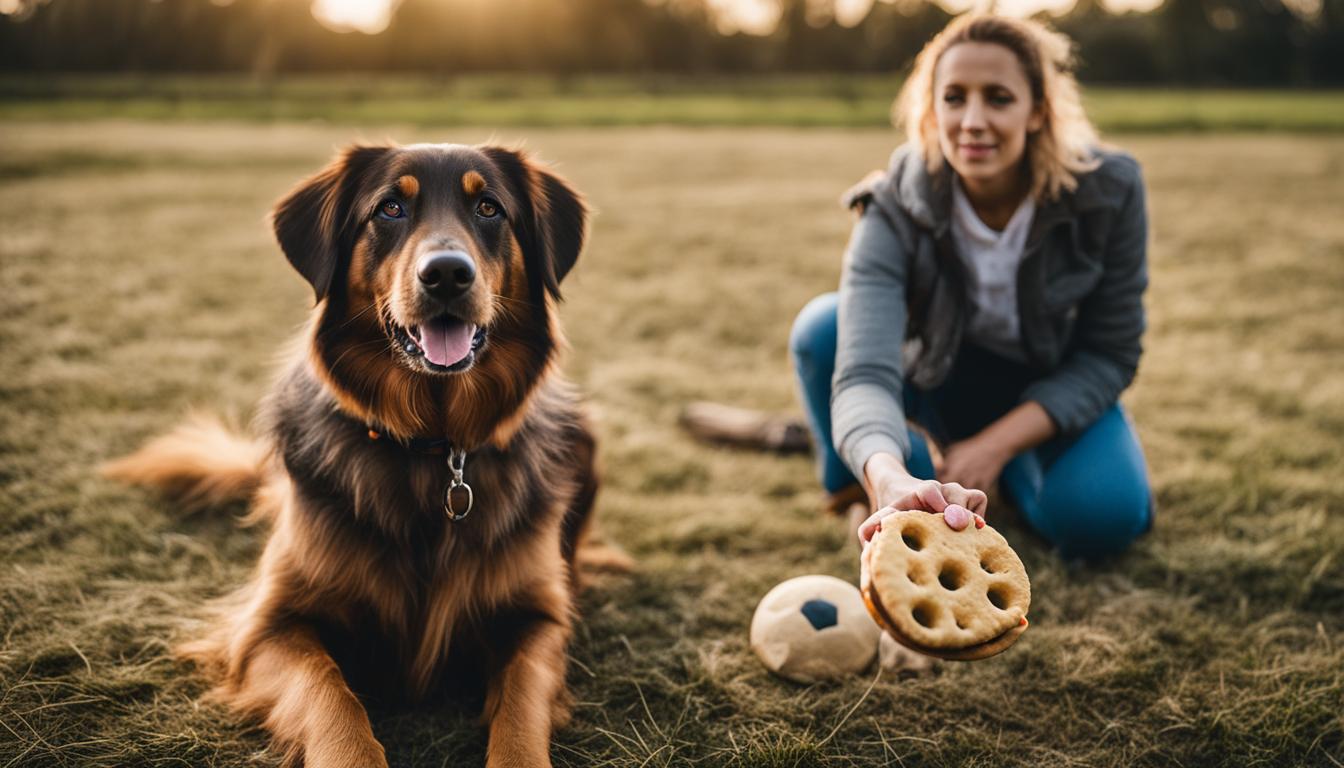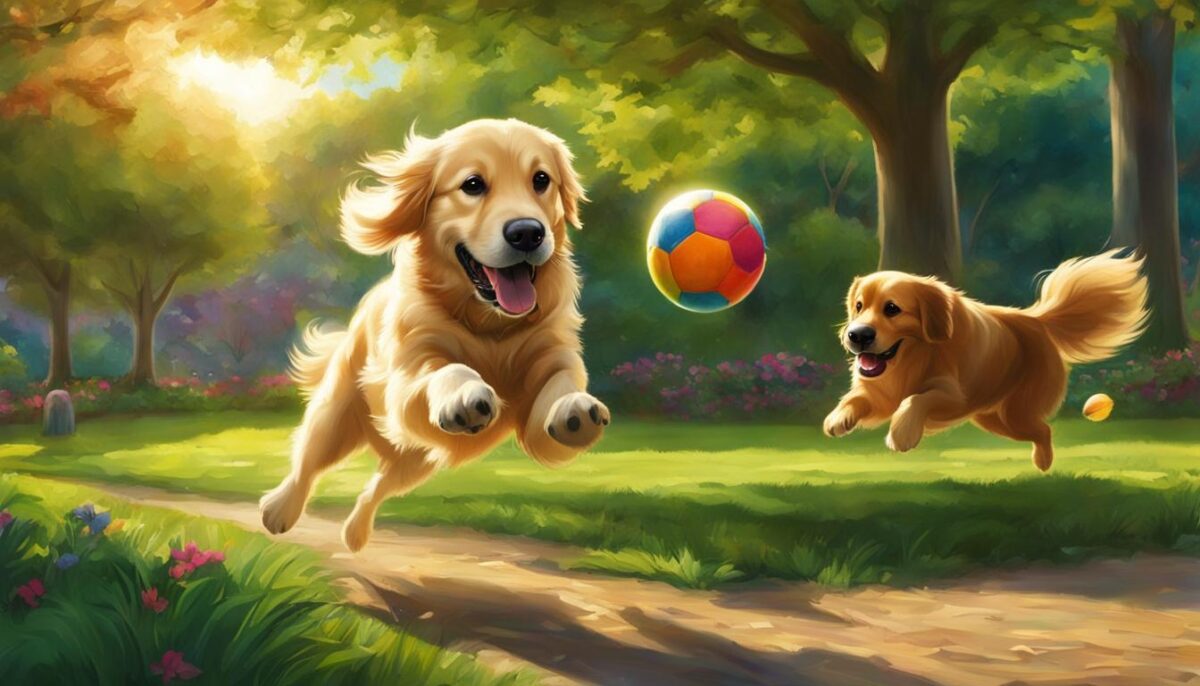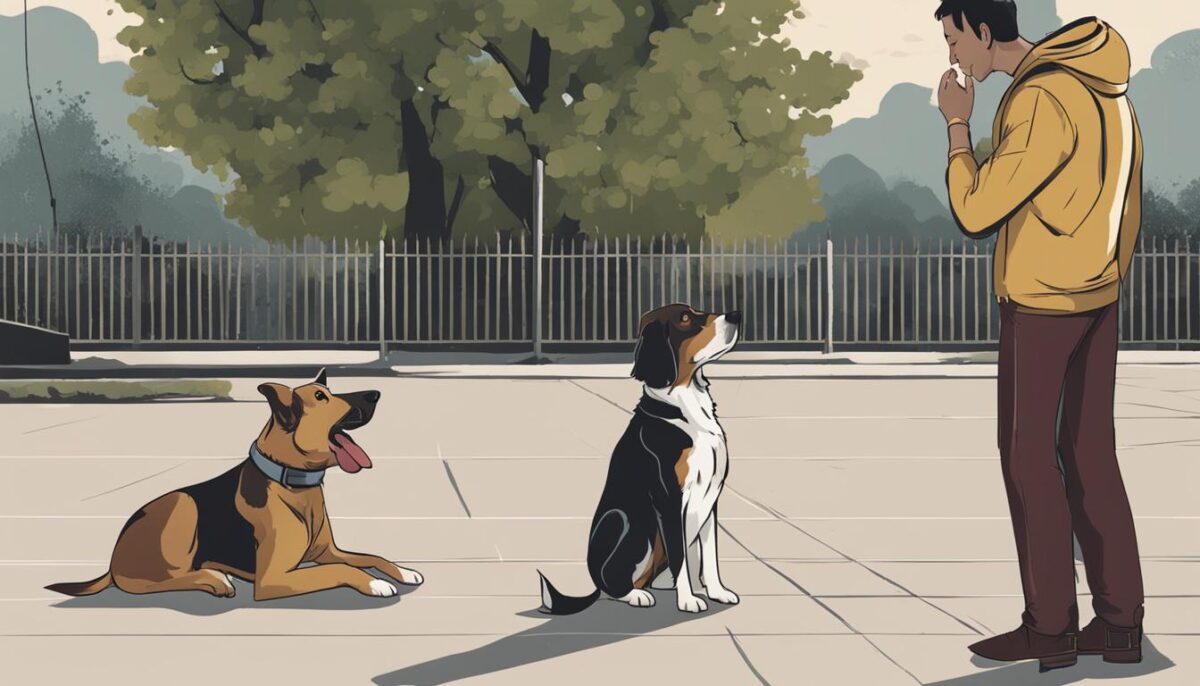Do you want your furry friend to come to you when you call them? It’s important for their safety, and it lets them have fun without a leash too. Teaching your dog to come to you is a big part of dog training. If you make it fun, they will want to come back to you all the time! This is what we call “quick recall training” and it’s really useful when you are outside or if there is an emergency. Always remember to follow the rules for leashes where you live, but playtime without a leash is good for your dog.
Key Takeaways
- Recall training is key for letting dogs play safely without a leash.
- Make training fun and rewarding for your dog.
- Taught right, dogs will be happy to come when called.
- Always follow local leash laws for your dog’s safety.
- Recall training is super useful for emergencies.
The Importance of Training Your Dog to Come When Called
Learning to come when called is one of the essential dog commands and a big part of dog safety. When dogs know the recall command, they can have fun without a leash and stay safe. Imagine playing with your dog in a big, open space. They can run and play, but when you say “come”, they rush back to you. That’s what off-leash safety is all about!
Imagine you’re in the park and your dog is off the leash, having a good time. Suddenly, a car comes zooming by. If your dog knows the recall command, you can call them back to you quickly to keep them away from danger. Isn’t that neat? You can help keep your furry friend safe just by teaching them to listen to you.
Training isn’t just about being safe; it’s also about having a good time with your best pal. Dogs love to play and explore. By teaching them to come when called, you give them the freedom to do this safely. They can chase a ball or sniff around, but they will know to come back to you when it’s important.
Always remember, keeping your dog safe is the most important part of having fun together!
- Recall Command: This is when your dog comes back to you after you call them.
- Dog Safety: This means keeping your dog out of harm’s way, like away from cars and other dangers.
- Off-Leash Safety: Letting your dog run around without a leash but still being able to keep them safe.
| Fun Activities | How Recall Helps |
|---|---|
| Playing fetch in the park | Your dog returns after chasing the ball |
| Hiking on a trail | Your dog can explore but comes back when you call |
| Visiting a dog-friendly beach | Your dog swims and plays but returns when it’s time to go |
Now you know how important it is to teach your dog to come when called. It keeps them safe and lets them have lots of fun. You’re a super team!
Defining Reliable Recall and Its Relevance
When you teach your dog to come back to you, it’s called reliable recall. This means your furry friend listens and returns to you almost every time you call them, no matter where they are or what’s happening around them. It’s important because it keeps them safe and lets them have fun without a leash.
Understanding What Makes Recall ‘Reliable’
A reliable recall happens when your dog thinks coming back to you is the best thing ever! You can make it fun by giving them treats or playing games. The key to training consistency is to always be happy when they come back, so they know it’s a good thing to do.
Why Reliable Recall Matters in Real-World Situations
In your everyday adventures, having a dog that comes back every time is super helpful. It stops them from getting into danger, like running into the street or meeting unfriendly animals. Whether at the park or in your backyard, knowing your dog will come to you brings peace of mind.
| Training Element | Why It’s Important |
|---|---|
| Listening Skills | Makes sure your dog pays attention to you |
| Fun Rewards | Teaches your dog that following your call is rewarding |
| Consistent Practice | Helps your dog remember to come back even when they’re excited |
| Safety First | Keeps your dog out of trouble and away from danger |
How to Train a Dog to Recall
Training your dog to respond to recall cues is a vital part of basic dog training. You’ll want to kick-off in a quiet spot without any distractions. This way, your pup can focus on you and your verbal commands.
Imagine you’re in a calm area. You have your dog’s favorite toys or some yummy treats. You’re ready to start. Call your dog’s name and a clear cue like “come” or “here.” When they start heading your way—praise them! This is their first step in learning important recall cues.
As your dog gets better at this, it’s time for a bigger challenge. Try waiting a bit before showing the treat or take a few steps back so they have to come a longer way. Always remember to cheer and reward your furry buddy every time they do it right.
| Steps | Techniques | Tips |
|---|---|---|
| Start Simple | Use favorite treats or toys | Keep sessions short and fun |
| Introduce the Cue | Clear verbal commands like “come” | Use a happy voice |
| Practice Makes Perfect | Repeat in different places | Vary the challenges gradually |
Remember, patience is key in training techniques. Sometimes dogs learn quickly, and other times they need a bit more practice. What’s important is that you both have a good time. Keep practicing in different places and soon, your dog will be a recall pro!
Introducing Your Dog to Recall Training Through Play
Teaching your fluffy friend to come when called can be super fun! Just like kids love games, your dog does too. When you play recall training games, you are helping your dog learn to listen and come back to you. It’s like making learning a really fun game they always want to win! Imagine playing a game where every time you do something right, you get a favorite treat. That’s how your dog feels with positive reinforcement.
Fun and Engaging Recall Games to Try
Let’s play some games that will make your dog a recall champion! These games are great for keeping your dog’s tail wagging and their brains working.
- Catch Me If You Can: Run away from your dog and call them to ‘come’. When they catch up, reward them with a treat or a hug!
- Hide and Seek: Hide somewhere and call your dog’s name. When they find you, it’s treat time!
Remember, every time your dog comes to you, it’s party time with lots of praise and treats. This is you saying, “Good job!”
Incorporating Rewards and Positive Reinforcement
Yummy treats, fun toys, or a game of tug can make your dog think, “Coming back is the best!” This is because they get rewarded for good behavior, and it makes them happy and excited to listen to you. Here’s a simple chart to show what rewards can do:
| Action | Reward | Result |
|---|---|---|
| Dog comes when called | Yummy treat | Happy, waggy tail! |
| Dog sits nicely | Fav toy | Dog wants to sit again! |
| Dog stays put | Extra playtime | Dog learns staying is fun! |
Each time you play these games and give rewards for good behavior, your dog understands that listening to you is awesome! This makes them want to come back to you even when there are other cool things around. Happy playing, and watch your furry friend become a recall superstar!
Common Recall Training Mistakes to Avoid
When you’re teaching your furry friend to come when called, there are some key training do’s and don’ts you need to remember. This will help your dog learn quicker and make training a fun time for both of you.
One of the big training pitfalls isn’t giving your dog a treat every time they come back to you. Your buddy loves getting a little snack or a pat as a ‘thank you’ for listening. If they don’t get it, they might not think it’s important to come next time.
Another tip is to be careful not to say “come here” too much without a good reason. If you call them back a lot when they’re playing or exploring, they may start thinking it’s just noise and not something they need to listen to. Here’s a simple list of things to keep in mind for an effective recall:
- Every time your dog comes back, give them a treat or a friendly pat.
- Don’t use the recall command unless you need your dog to come back for sure.
- Make sure to celebrate when they return to you, so they know they did a great job.
Understanding how your dog thinks and learns is a big part of training them well. Avoiding these mistakes can help your dog’s behavior improve and can teach them to listen to you because they want to, not just because they have to.
Keep these tips in mind, and you’ll see that with patience and practice, you and your dog can learn anything together!
Strategies for Dealing with a Poisoned Cue
When your dog doesn’t listen to the recall command anymore, it’s like the word you’ve been using has lost its magic. This means it’s time for poisoned cue recovery, which is like hitting the reset button on your dog’s training. Don’t worry, you can teach your furry friend a fresh, new command that they’ll listen to.
Identifying When Your Command Has Lost Effectiveness
It’s important to tell if your dog has stopped listening to the recall cue because they might feel mixed up or think the command is not fun anymore. This can happen if they’ve been told off when they came back to you, or if the cue was used too much without any treats or playtime to follow. You might see your dog hesitate, or not come back at all when you call them. This is when you should think about recall command retraining.
Steps to Refresh and Reinforce the Recall Cue
To make coming back to you the best part of your dog’s day, you can start by picking a new word that’s just for calling them back. Use this new cue only when you’re sure they will come, and have some awesome treats ready to cheer them on. Here’s a simple way to rebuild the recall response:
- Pick a new recall word, like “here” or “quickly.”
- Start in a quiet place without distractions.
- Show your dog a yummy treat and say the new cue happily.
- Give them the treat and lots of praise when they come to you.
- Train a little bit every day, and soon your dog will learn that the new word means good things happen!
With patience and lots of practice, your dog will learn to listen to the new recall command. Remember, always keep training fun and full of surprises, like treats and games, so your dog is eager to come back every time you call.
Advanced Recall Training Tips for Distractions and Distance
Training your dog can be a fun adventure, especially when you start moving on to more advanced dog training. Now, let’s make your furry friend a pro at overcoming distractions and mastering long-distance recall. We have some tips for you!
First off, always start small and then go big. After your dog has nailed recall in your backyard, you can step up the game. Try going to the park where there are more things going on to distract your pup.
Just remember, practice makes perfect. You and your dog are a team, working together to become better every day. Keep it up!
Also, you don’t always need to have treats in hand. As your dog gets better, use the power of your praise. A happy “Good dog!” can work wonders.
Here’s a neat way to see how you can level up the challenges for your dog:
| Stage | Location | Distractions | Distance |
|---|---|---|---|
| Easy | Home | Few (e.g., Family members) | Short (Within a room) |
| Moderate | Park | Moderate (e.g., Other dogs, joggers) | Medium (Across the park) |
| Difficult | Beach | Many (e.g., Swimmers, loud noise) | Long (Down the beach) |
When you keep giving your dog these fun tasks, they’ll learn to focus on you even with the craziest things going on around them. Safety first, but let’s make it super fun too!
- Start with a quiet place, then visit a busier spot.
- Give your dog time to get used to each stage before moving on.
- Celebrate with your dog when they do a great job!
With time, your dog will be a superstar, paying attention to you, no matter how far away they are or what’s happening around them. You got this!
Conclusion
Mastering recall with your furry friend is a huge step towards ensuring their safety and granting them the joy of freedom. This journey of dog training success begins with understanding the basics and building step by step. Keeping training fun with games and treating rewards makes the experience enjoyable for you and your pup.
Avoiding those common slip-ups is just as important. Remember, patience is your best friend in this process. By staying the course and tackling one challenge at a time, you can craft a stellar recall that works when you need it most. It’s all about creating that effective recall training summary in your everyday practice – a little goes a long way!
As your dog gets better, don’t forget to up the game. Moving to places with more going-ons and adding some distance will test and improve your dog’s skills. With commitment and love, you will see a remarkable recall mastery, and your pup will come running back to you like a champ, in parks, woods, or wherever adventures may lead!
FAQ
Why is it important to train my dog to come when called?
Teaching your dog to come when called is essential for their safety and yours. It allows for off-leash freedom in appropriate environments and can prevent dangerous situations, such as running into traffic or coming across aggressive animals.
What does ‘reliable recall’ mean, and why is it important?
Reliable recall means your dog will return to you promptly on command almost every time, regardless of distractions. It’s important because it gives you control in various situations and can be a lifesaving command in emergencies.
How can I start training my dog on the recall command?
Begin training in a quiet area with no distractions. Use high-value rewards and positive reinforcement when they come to you. Start with short distances and gradually increase difficulty as your dog improves.
What are some recall training games I can play with my dog?
Engaging games like ‘Catch Me,’ ‘Find Me,’ and ‘Hot Potato’ can be used to teach recall in a fun way. They help to make the training process enjoyable for both you and your dog, strengthening the recall command.
Can I use the recall command to end playtime with my dog?
It’s best not to frequently use the recall command to end playtime as this may create negative associations. Instead, call them, reward them, and then allow them to continue playing before calling them to end the session for good.
What should I do if my dog is no longer responding to the recall command?
If the recall command has become ‘poisoned’ or ineffective, pick a different command and retrain your dog using positive reinforcement. Start from scratch in a controlled environment to rebuild a positive association with the new command.
How do I increase the level of difficulty in recall training?
Once your dog responds well in a distraction-free environment, gradually introduce new challenges. Train in places with more distractions, increase the distance, and create scenarios that mimic real-life situations where you need them to come reliably.
How can I ensure my dog’s recall command is effective in any situation?
Consistency is key. Train regularly and in various situations. Over time, reduce reliance on treats and focus on praise and other forms of positive reinforcement. This helps establish a reliable recall regardless of the environment or distractions.


